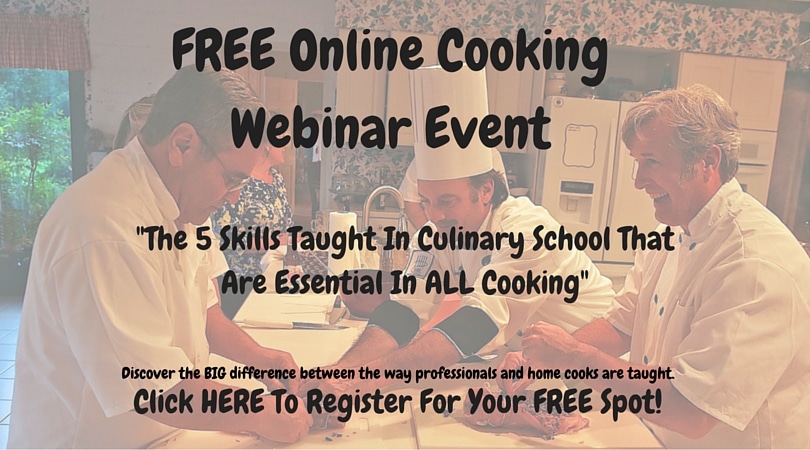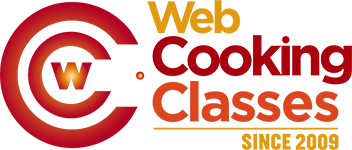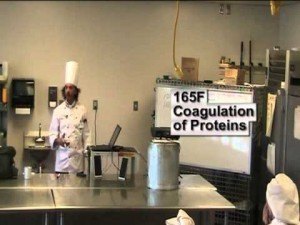It’s a new semester at culinary college, and the grandest question I can answer for the students is “How does food cook?” The easy answer is that food cooks when we transfer heat from a source to the food product.
In the previous class I asked a similar question. “Do you know the two types of heat for cooking?” This also seems like a daunting question, but these topics are crucial to success in becoming a professional chef. The students learned that all food is cooked in one of two ways, convectively and conductively.
Convection is when heat is applied indirectly, conduction is direct application of heat. However, regardless of the WAY heat is applied, all food items have the same reactions at certain temperatures.
Whether you poach a chicken breast or grill a chicken breast, you can be sure that the end result will be smaller than the raw product. Protein products stiffen and shrink when you apply heat, either directly or indirectly, dry or moist.
Sometimes you can achieve a nice brown color during sauté, or create characteristic grill marks when grilling. These are similar effects of heat on food no matter what method you decide to use in cooking it.
The answer to “How does food cook?” is a very important one that will guide my class of future professional chefs because they are mile-markers on the road to cooking anything. Being able to recognize the results of the four main temperature points will take their cooking from fair to fantastic.
Mile-markers are crucial in any journey. If you cook with a written recipe but don’t recognize the temperature progression of the effects of heat on food, it’s like driving with a roadmap while blindfolded. You may have all the instructions, but you’ll never see the landmarks along the way, and you’ll never know when you’ve arrived at the destination.
At 150 degrees Fahrenheit, (65c) starches gelatinize. Starches in food absorb liquid and swell at this temperature. You’ve witnessed this if you’ve every made rice. The combination of heat, raw rice and liquid results in bigger rice and no liquid. Gelatinization of starches starts at 150f and is the way to thicken sauces as well.
At 165 degrees Fahrenheit, (74c) proteins coagulate. This is the temperature that solves the ‘how does food cook’ puzzle. When you apply heat to protein products, they stiffen and shrink. This is coagulation of proteins. Everyone has seen the difference between a raw hamburger and the cooked result. It shrinks and stiffens.
Coagulation of proteins is an important landmark in the cooking progression because it’s the temperature at which most items are finished cooking. When your chicken breast turns from pink to white, you’re seeing coagulation of proteins.
At 212 degrees Fahrenheit, (100c)moisture evaporates. You might remember this from grade school. Water turns to steam at 212 f or 100c. This is how roasted items dry out. Roasting is a dry convective cooking process where heat is transferred through dry air. At 212f the air helps evaporate moisture, drying the product being cooked.
At 320 (160c) degrees Fahrenheit, sugars caramelize. The sugars in food turn brown and get brittle, just like making candy or peanut brittle. Caramelization of sugars is what gives you the attractive grill marks or browned plate appeal of a well cooked item.
Upon internalizing this 4 temperature progression, you can start to answer a few of your own questions. Perhaps you wonder why steamed fish never turns brown. Wonder no more!
Steam never gets hotter than 212f or 100c, much lower than the 320f needed to caramelize sugars. Steamed food will never get brown. Similarly, items that are poached or boiled will never reach the necessary temperature for a caramel color and plate appeal.
So, how does food cook? It cooks by making its way through the progression of temperatures that act upon the starches, proteins, moisture and sugars found in most foods. HOW you manage and direct its journey through this zone will dictate the color, texture and nutritional value of everything you cook.
Discover the difference between how professionals and home cooks are taught in my next
FREE Webinar Workshop
Claim your FREE Spot for the next webinar session by CLICKING HERE



It is good to know what happens at what temperature and why. The only thing I am concerned about is the boiling point and evaporation. Water evaporates at all temperatures, even from frozen, that’s why the ice cubes you put in the freezer 2 months ago have shrunk. It evaporates increasingly faster as the temperature increases and, as you said, 212*F cannot be exceded at normal atmospheric pressure. Increasing the heat further will just cause even faster evaporation but no increase in temperature as long as water remains.
I always enjoy your classes, thanks.
Hi Wally!
You’re correct. Hydrogen and Oxygen (water) will escape into the atmosphere at different temperatures.
However, for our uses in cooking we examine what happens when we apply HEAT to food.
And, to get really technical, different starches will gelatinize at different temperatures.
Sugars, depending on the molasses content, will carmelize at different temperatures also.
The basic progression of 150, 165, 212, 320 degrees is meant for people to anticipate and visualize their cooking.
This is just the beginning, but a good basis for understanding what the elements in food go through when cooked.
Congratulations Chef on your achievement!
I finally get money back from Uncle Sam this year and looking forward to a lifetime membership in Web Cooking Classes. Time to get out of the cover band and become a better musician.
Thanks for the kind words, Dave.
I love your rock band analogy. Cooking is so much like music to me.
Cheers!
VERY INFORMATIVE! I NEED MORE!!!
Congratulations!!! So proud of you!!